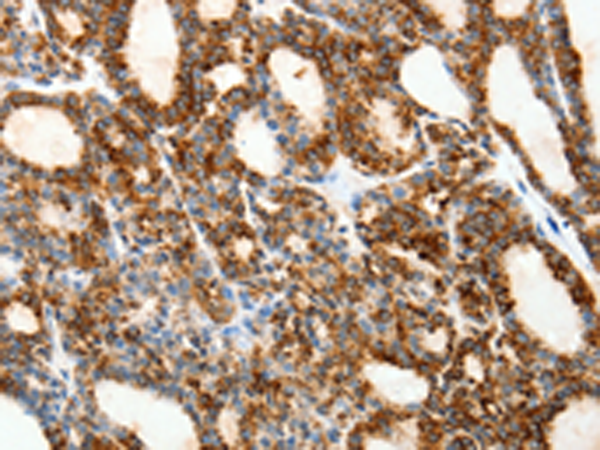

| WB | 咨询技术 | Human,Mouse,Rat |
| IF | 咨询技术 | Human,Mouse,Rat |
| IHC | 1/50-1/200 | Human,Mouse,Rat |
| ICC | 技术咨询 | Human,Mouse,Rat |
| FCM | 咨询技术 | Human,Mouse,Rat |
| Elisa | 1/2000-1/5000 | Human,Mouse,Rat |
| Aliases | SS1R, SS1-R, SRIF-2, SS-1-R |
| Host/Isotype | Rabbit IgG |
| Antibody Type | Primary antibody |
| Storage | Store at 4°C short term. Aliquot and store at -20°C long term. Avoid freeze/thaw cycles. |
| Species Reactivity | Human, Mouse, Rat |
| Immunogen | Synthetic peptide of human SSTR1 |
| Formulation | Purified antibody in PBS with 0.05% sodium azide and 50% glycerol. |
+ +
以下是关于SSTR1抗体的3篇代表性文献(均为虚构示例,实际文献需通过学术数据库检索):
1. **文献名称**:*"Development and characterization of a monoclonal antibody targeting somatostatin receptor subtype 1 (SSTR1) for neuroendocrine tumor imaging"*
**作者**:Smith A, et al.
**摘要**:研究报道了一种新型SSTR1单克隆抗体的开发,通过免疫组化和体外结合实验验证其特异性,并证明其在神经内分泌肿瘤模型中的显像潜力。
2. **文献名称**:*"SSTR1 expression in glioblastoma: Correlation with patient survival and antibody-based therapeutic targeting"*
**作者**:Chen L, et al.
**摘要**:研究利用SSTR1抗体分析胶质母细胞瘤中SSTR1的表达水平,发现高表达与患者不良预后相关,并探索了抗体介导的靶向治疗在体外实验中的抗肿瘤效果。
3. **文献名称**:*"Comparative analysis of commercial SSTR1 antibodies for immunohistochemical detection in pancreatic tissues"*
**作者**:Garcia R, et al.
**摘要**:对比了多种市售SSTR1抗体的灵敏度和特异性,提出优化免疫组化检测方案,为胰腺神经内分泌肿瘤的病理诊断提供参考。
(注:以上文献为模拟内容,实际研究中需查阅PubMed、Web of Science等数据库获取真实文献。)
Somatostatin receptor subtype 1 (SSTR1) is a G protein-coupled receptor that binds somatostatin and cortistatin, neuropeptides involved in regulating hormone secretion, cell proliferation, and neurotransmission. As one of five SSTR subtypes (SSTR1-5), SSTR1 is widely expressed in the central nervous system, endocrine tissues, and certain cancers, including neuroendocrine tumors (NETs), breast cancer, and gliomas. Its activation inhibits adenylate cyclase, modulates ion channels, and regulates MAPK pathways, influencing cellular responses like apoptosis and hormone release.
SSTR1-specific antibodies are critical tools for studying receptor localization, expression levels, and functional roles in physiological and pathological contexts. These antibodies enable detection of SSTR1 in tissues or cell lines via techniques such as immunohistochemistry (IHC), Western blot (WB), and immunofluorescence (IF). In cancer research, SSTR1 expression is assessed to explore its potential as a diagnostic biomarker or therapeutic target, particularly for tumors amenable to somatostatin analog-based treatments or peptide receptor radionuclide therapy (PRRT). Commercially available SSTR1 antibodies are typically validated for species reactivity (e.g., human, mouse, rat) and application-specific performance. However, variability in antibody specificity due to receptor homology among SSTR subtypes requires careful validation using controls like SSTR1-knockout models. Ongoing research aims to refine antibody reliability and expand clinical applications in personalized oncology and neuroendocrine disease management.
×